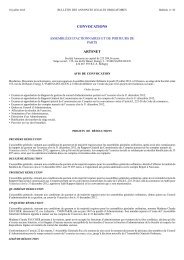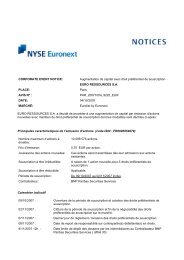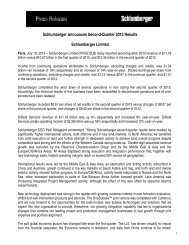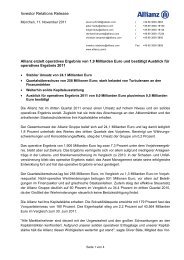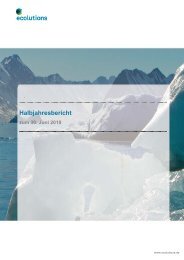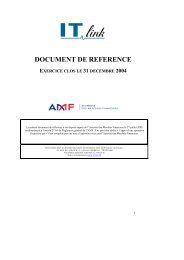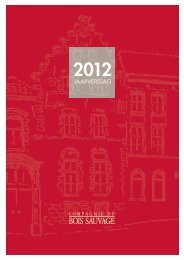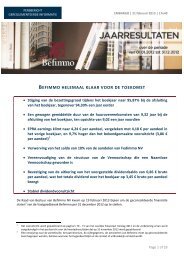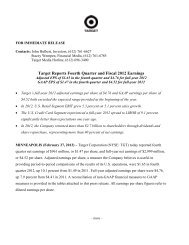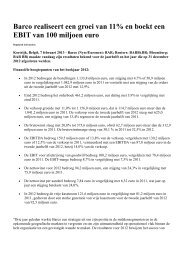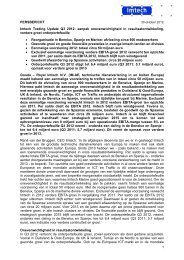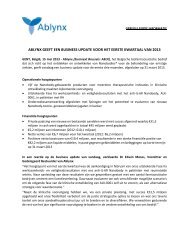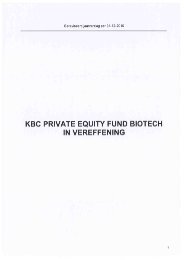Download full Annual Report and Accounts - Kingfisher
Download full Annual Report and Accounts - Kingfisher
Download full Annual Report and Accounts - Kingfisher
Create successful ePaper yourself
Turn your PDF publications into a flip-book with our unique Google optimized e-Paper software.
98<br />
1 Principal accounting policies continued<br />
e. Employee benefi ts<br />
(i) Pensions<br />
Notes to the Company<br />
fi nancial statements<br />
Kingfi sher plc<br />
<strong>Annual</strong> <strong>Report</strong><br />
<strong>and</strong> <strong>Accounts</strong><br />
2009/10<br />
The Company operates defi ned benefi t <strong>and</strong> defi ned contribution pension schemes for its employees. A defi ned benefi t scheme is a pension scheme that defi nes<br />
an amount of pension benefi t that an employee will receive on retirement. A defi ned contribution scheme is a pension scheme under which the Company usually<br />
pays fi xed contributions into a separate entity. In all cases a separate fund is being accumulated to meet the accruing liabilities. The assets of each of these funds<br />
are either held under trusts or managed by insurance companies <strong>and</strong> are held entirely separate from the Company’s assets.<br />
The asset or liability recognised in the balance sheet in respect of defi ned benefi t pension schemes is the fair value of scheme assets less the present value of<br />
the defi ned benefi t obligation at the balance sheet date, together with an adjustment for any past service costs not yet recognised. The defi ned benefi t obligation<br />
is calculated annually by independent actuaries using the projected unit credit method. The present value of the defi ned benefi t obligation is determined by<br />
discounting the estimated future cash outfl ows using interest rates of high quality corporate bonds which are denominated in the currency in which the benefi ts<br />
will be paid <strong>and</strong> which have terms to maturity approximating to the terms of the related pension liability.<br />
Actuarial gains <strong>and</strong> losses arising from experience adjustments <strong>and</strong> changes in actuarial assumptions are charged or credited directly to the profi t <strong>and</strong> loss<br />
reserve as they arise.<br />
Past service costs are recognised immediately in the profi t <strong>and</strong> loss account, unless the changes to the pension scheme are conditional on the employees<br />
remaining in service for a specifi ed period of time (the vesting period). In this case, the past service costs are amortised on a straight line basis over the vesting<br />
period.<br />
For defi ned contribution schemes, the Company pays contributions to privately administered pension schemes on a contractual basis. The Company has<br />
no further payment obligations once the contributions have been paid. The contributions are recognised as an employee benefi t expense when they are due.<br />
Prepaid contributions are recognised as an asset to the extent that a cash refund or a reduction in future payments is available.<br />
(ii) Share-based compensation<br />
The Company operates several equity-settled, share-based compensation schemes. The fair value of the employee services received in exchange for the grant of<br />
options or deferred shares is recognised as an expense <strong>and</strong> is calculated using Black-Scholes <strong>and</strong> stochastic models. The total amount to be expensed over the<br />
vesting period is determined by reference to the fair value of the options or deferred shares granted, excluding the impact of any non-market vesting conditions.<br />
The value of the charge is adjusted to refl ect expected <strong>and</strong> actual levels of options vesting due to non-market vesting conditions.<br />
(iii) Employee Share Ownership Plan Trust (‘ESOP’)<br />
The ESOP is a separately administered discretionary trust. Liabilities of the ESOP are guaranteed by the Company <strong>and</strong> the assets of the ESOP mainly comprise<br />
shares in the Company.<br />
Own shares held by the ESOP are deducted from equity shareholders’ funds <strong>and</strong> the shares are held at historical cost until they are sold. The assets, liabilities,<br />
income <strong>and</strong> costs of the ESOP are included in both the Company’s <strong>and</strong> the consolidated fi nancial statements.<br />
f. Deferred tax<br />
Provision is made for deferred tax using the incremental provision approach <strong>and</strong> is measured on an undiscounted basis at the tax rates that are expected to<br />
apply in the periods in which timing differences reverse, based on tax rates <strong>and</strong> laws substantively enacted at the balance sheet date.<br />
Deferred tax is recognised in respect of timing differences that have originated but not reversed by the balance sheet date subject to the following:<br />
– Deferred tax is not recognised on the revaluation of non-monetary assets such as property unless a binding sale agreement exists at the balance sheet date.<br />
Where rollover relief is available on an asset then deferred tax is not recognised.<br />
– Deferred tax is recognised on unremitted earnings of overseas subsidiaries <strong>and</strong> associates only where dividends are accrued as receivable or there is an<br />
intention to remit these in the foreseeable future.<br />
– Deferred tax assets are recognised to the extent that they are regarded as recoverable. Assets are regarded as recoverable when it is regarded as more<br />
likely than not that there will be suitable taxable profi ts from which the future reversal of the underlying timing differences can be deducted.<br />
– Deferred tax is not recognised on permanent differences.<br />
g. Provisions<br />
Provisions are recognised when the Company has a present legal or constructive obligation as a result of past events, it is more likely than not that an outfl ow<br />
of resources will be required to settle the obligation <strong>and</strong> the amount can be reliably estimated. Provisions are not recognised for future operating losses.



